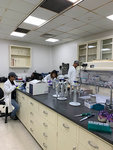Wind: mph,
Welcome to our new web site!
To give our readers a chance to experience all that our new website has to offer, we have made all content freely avaiable, through October 1, 2018.
During this time, print and digital subscribers will not need to log in to view our stories or e-editions.




You might say New Mexico State University faculty Ph.Ds. Richard Heerema and Jennifer Randall are bringing pecans out of their shells.
Heerema, an NMSU Cooperative Extension Service pecan specialist, and Randall, a plant molecular biologist and plant pathologist in the NMSU Department of Entomology, Plant Pathology and Weed Science, are studying the pecan genome to develop pecan trees with the right genetics for specific climates, including the Southwest.
The ultimate goal of mapping a complete set of all genetic instructions (the genome) for the pecan is “more profitable and efficient orchards,” said Heerema, who has a Ph.D. in plant biology and is one of only a handful of pecan specialists in the United States. NMSU wants to help pecan growers “do what they do and do it well,” he said.
“The broad genetic diversity available in specialty crops (including pecans) will be crucial when adapting cultivars (varieties) to new or changing pests, environmental conditions and consumer demands,” Randall wrote in an article published last June in the journal “Nature Communications.” Randall is director of NMSU’s Molecular Biology Graduate Program and principal investigator of a U.S. Department of Agriculture grant that is helping fund NMSU’s pecan research. She has a Ph.D. in molecular biology.
Pecans are a major nut crop consumed around the world, Heerema said, and the only nut tree native to North America. Even though they are not indigenous to New Mexico, “they are very, very well adapted to New Mexico’s environment,” he said.
The state is today second only to Georgia in commercial pecan production. Doña Ana County, which produces 70 percent of New Mexico’s pecan crop, is the single largest pecan-producing county in the United States. The versatile and beloved pecan has become not only a staple of the local diet; its orchards, producers – and genetics – are icons of the culture and a major attraction to visitors.
Heerema said NMSU has become a repository for pecan seeds and trees from throughout the region where pecans grow naturally, which stretches from central Mexico to northern Illinois, including parts of eastern Texas and Oklahoma.
NMSU is working with collaborators across the country to discover where a pecan’s most desirable traits are coded for in its genes, Heerema and Randall said.
“Modern pecan breeding has made some significant strides by selecting for genotypes with larger nut size, higher nut quality, and tree tolerances of abiotic (living) and biotic (non-living) stresses,” Randall wrote in Nature Communications. Stresses include disease, pests, heat, high elevation, aridity and high salinity levels in water and soil.
Scientists are also targeting the size of pecan trees in their breeding research so growers can plant more trees per acre, Randall said. And they are testing new irrigation methods to ensure that pecan trees “receive the right amount of water at the right time,” Heerema said.
NMSU is also studying yield to determine why trees produce a large crop of pecans one year and a smaller crop the next, and why trees bud earlier in Mexico and leaf out later the farther north you go, Heerema said.
In fact, it was work on finding the gene the controls when pecan trees flower that brought Heerema and Randall together in 2009.
Randall has eight students working on the pecan genome project in her pecan lab at NMSU and in the field, grafting parts of one genetically different pecan tree onto another, studying rootstock, soil and water issues and examining the pecans themselves, since each nut has its own unique DNA.
“She brought these people from all over the country to get this genome done,” Heerema said.
“I’m so blessed with the students and collaborators that I have,” Randall said. “We are building on the foundation of the science that came before us.”
New Mexico’s pecan pioneers include NMSU horticulturalist and national agriculture hall of fame member Fabian Garcia, who planted some of New Mexico’s first pecan trees in the Mesilla Valley in 1913. Many of the trees he planted in 1915 continue to thrive and produce, and are visible from University Avenue at the Fabian Garcia Science Center, where work is continuing to discover the secrets of the pecan.
“We never know everything,” Randall said. “There’s so much more to learn.”
Visit www.pecansouthmagazine.com/magazine/article/family-trees-roots-resilience/
Other items that may interest you

